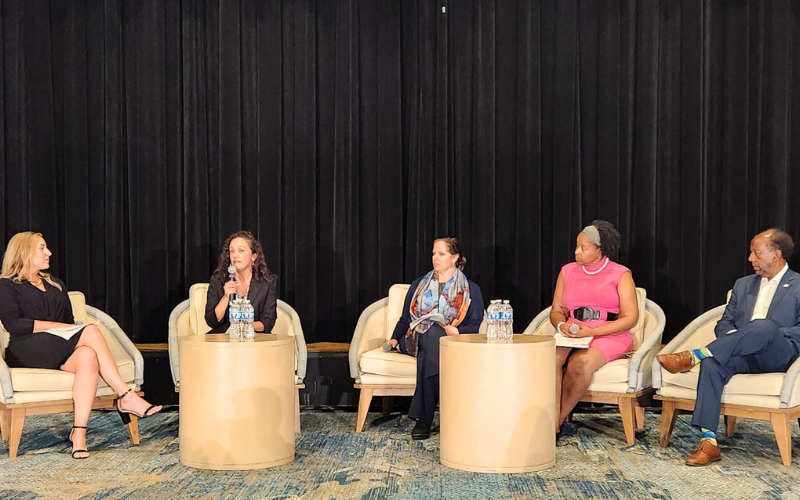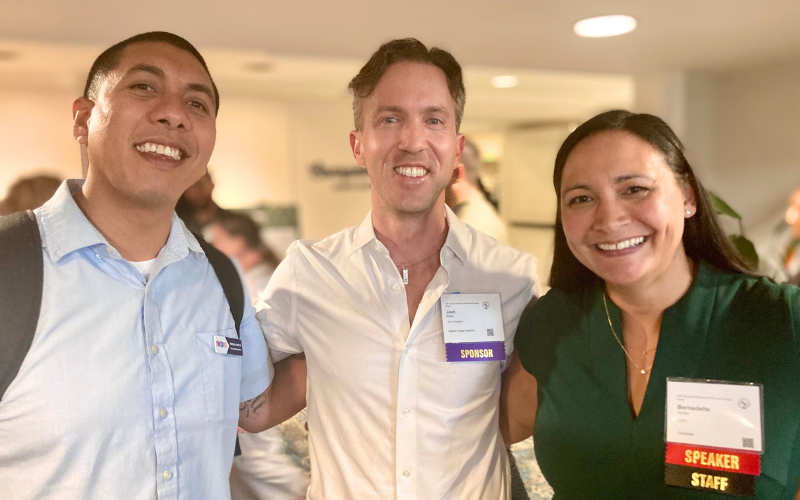July 30, 2024
Topic
At the end of June, more than 425 climate and energy leaders from across the state gathered in Palm Springs for the 15th annual California Climate and Energy Forum (CCEC Forum). Attendees represented local, regional, and state governments; private sector service providers; sustainability departments; practitioners; and nonprofit organizations.
Hosted by the California Climate & Energy Collaborative (CCEC)—a CivicWell initiative funded by the state’s Regional Energy Networks—the CCEC Forum convenes government and industry leaders from across the state to share best practices and cutting edge innovations in the climate and energy field. This year’s theme, Collective Innovation: Cultivating Collaboration for Equitable Action, honored the connections and partnerships built over the 15 years of the CCEC Forum and recognized the powerful opportunity we have to advance equitable, cross-sector, collective climate action.
In her opening remarks, CivicWell CEO Bernadette Austin noted that gatherings like the CCEC Forum are crucial avenues that lay the groundwork for ongoing coordination. “As we work together towards common goals, we must continue to center collaborative and equitable approaches in all we do,” she said. “We are all deeply aware of how pending legislation, the state budget, national election, and many more factors have the potential to transform our work and change the trajectory of the industries we work in. It is in all of our best interests to find ways to support each other in the challenges ahead.”


“Collaboration is vital to accomplishing our clean energy goals.”
The Forum began with a welcome from Palm Springs Mayor Jeffrey Bernstein, who spoke to the city’s commitment to renewable energy, reducing carbon emissions, and improving energy efficiency in commercial buildings.
The opening plenary, The State of Climate and Energy in California in 2024, featured Samuel Assefa, Director of the Governor’s Office of Planning and Research; U.S. Department of Energy Director of Community Engagement Rose Dady; California Public Utilities Commissioner Darcie Houck; and California Energy Commissioner Noemí Gallardo. The panel, moderated by CCEC Statewide Best Practices Coordinator Angie Hacker, examined key policies and trends in the state and federal landscapes. Speakers reflected on the progress being made toward crucial climate goals and explored emerging opportunities.
Commissioner Gallardo noted the importance of working together across sectors to achieve sustainability objectives: “I am honored to have been invited to share my perspective as a CEC Commissioner at the 2024 CCEC Forum. It provides an incredible experience where leaders throughout California can learn from each other and connect to address climate change issues. Collaboration is vital to accomplishing our clean energy goals. The CEC appreciates the work that local governments and their partners are doing to contribute to a 100% clean energy future.”




Deepening Conversations and Connections
Over the two days of the Forum, participants attended breakout sessions on topics ranging from setting equity guardrails for the emerging California hydrogen market and metered energy savings programs, to Tribal climate planning perspectives and community engagement considerations for gas decommissioning. Deepening collaboration and connections was a prominent theme in both the program and conversations between forum participants.
“One of the biggest value propositions of this conference is the specificity,” stated Dr. Courtney Henderson, Councilmember and Former Mayor of the Town of Truckee, and Founder of Hawks Peak Strategies, Inc. “Because we’re focused on California, we can do a deep dive into policy, the regulatory landscape, what the Regional Energy Networks and CCAs are working on, real life case studies, and other areas that are crucial in the creation of a more energy-resilient future.”
City of Indio Councilmember Oscar Ortiz also spoke to the depth of the conversations he had: “The CCEC Forum is a great place to fine-tune your projects—you can bring your ideas and people will give you helpful critiques on them. And that’s what we need to create better proposals! You can meet with the people who finance the projects, those who get the financing, and acquire more expertise on new state and federal programs.”


“Many reasons to be hopeful”
The Day Two plenaries focused on regional considerations in the Inland Empire and the role of collaboration in equitable climate action. The morning plenary, Uniting Forces: The Inland Empire’s Approach to Energy and Climate Challenges, brought together local and regional leaders to discuss strategies for tackling clean energy adoption, emission reductions, and environmental justice, and to offer insights into the innovative approaches and collaborative efforts driving equitable change throughout the region.
Moderator Karina Camacho of the Inland Regional Energy Network noted, “It was an informative and educational panel, and showcased many reasons to be hopeful for the change we can bring here.”
The CCEC Forum closed with speakers Donnel Baird, CEO of BlocPower; San Joaquin Valley Clean Energy Organization Executive Director Courtney Blore Kalashian; and Lujuana Medina, EID Division Manager for the County of Los Angeles, on how private sector, nonprofit stakeholders, state agencies, and local government leaders are building a collaborative and inclusive future as we work to meet our climate and energy goals. The panel was moderated by Emi Wang of The Greenlining Institute.


CCEC is funded by the state’s Regional Energy Networks (RENs), administrators of energy efficiency programs authorized by the CPUC to draw on capacity and innovative ideas from local governments. The RENs’ unique design enables them to provide holistic solutions for customers, serve hard-to-reach communities, and more accurately address regional energy efficiency needs.
Jane Elias, Energy Director for the Bay Area Regional Energy Network, spoke to the timeliness of this year’s theme. “This is a pivotal year for Regional Energy Networks, and this forum provided an opportunity for so many to learn about the value local governments provide in ensuring the climate arena embraces equitable actions,” she said. “We had an unprecedented turnout that incorporated a wide range of participants reflecting a broad breadth of expertise and representation. I was inspired by the collective knowledge and ideas shared that will drive opportunities in climate action.”
In addition to the RENs, the CCEC Forum was also sponsored by agencies from across the climate and energy sector. Jackson McDonough attended as a representative of sponsor CalCCA, which aims to create a legislative and regulatory environment that supports the development and long-term sustainability of California’s Community Choice Aggregation electricity providers. He shared, “It’s been a great experience. I’ve been able to connect easily and efficiently with our own membership, new partners that are developers, even people working at nonprofits who are interested in collaborating with us. I’m already looking forward to following up and connecting people who want to do great work in advancing California’s renewable energy sector.”
Want to Get Involved?
CCEC supports California local governments to save energy, reduce greenhouse gas emissions, and accelerate climate action by building knowledge and networks amongst local government practitioners. Every second Tuesday CCEC hosts Local Energy Resources Network (LERN) meetings to exchange knowledge, resources, input, and opportunities to help California local governments pursue their energy and climate goals. Sign up here to attend.

Policy Corner
A Closer Look at the 2024 Climate Bond
As Governor Gavin Newsom and the Legislature grappled with closing a $46.8 billion shortfall in the state budget for 2024-25, programs to address climate change suffered significant cuts. Expenditures for climate change initiatives have been reduced from $54 billion to $45 billion—a 17% reduction—which touches nearly every program. In order to try to offset the cuts, the Governor and Legislature agreed to place a bond measure on the ballot for the upcoming November election. The bond measure is embodied in SB 867 by Senator Ben Allen, and will appear on the ballot as Proposition 4.
The popularly-named Climate Bond totals $10 billion and specifies that 40% of the funds must be spent on programs and projects that benefit vulnerable populations and disadvantaged communities. Here are some highlights of the measure, which is divided into several categories:
1. $3.8 billion for safe drinking water, flood, drought, and water resilience
- $610 million for safe drinking water through the State Water Resources Control Board (SWRCB)
- $200 million for the Multibenefit Land Repurposing Program (MLRP) through the Department of Conservation (DOC)
- $386.25 million for groundwater recharge, storage, conjunctive use, and Sustainable Groundwater Management Act (SGMA) implementation through the Department of Water Resources (DWR)
- $386.25 million for water reuse and recycling through the SWRCB
- $550 million for flood management projects through the California Natural Resources Agency (CNRA)
2. $1.5 billion for wildfire and forest resilience
- $1.205 million for fire prevention and improving forest health and resilience to the CNRA and its departments
- $135 million for wildfire mitigation through the Office of Emergency Services (OES)
3. $1.2 billion for coastal resilience
- $415 million to increase resilience of beaches, bays, watersheds, and other areas through the State Coastal Conservancy
- $350 million for coastal and shoreline flood management through the State Coastal Conservancy
- $75 million for the California Sea Level Rise Mitigation and Adaptation Act of 2021
4. $450 million for extreme heat
- $50 million for Extreme Heat and Community Resilience Program through the Office of Planning and Research (OPR)
- $150 million for the Transformative Climate Communities Program (TCC) through the Strategic Growth Council (SGC)
- $100 million for urban greening through CNRA
- $50 million for urban forests through the Department of Forestry and Fire Protection
- $60 million for community resilience centers through OES and SGC
5. $1.2 billion for nature-based climate solutions and to protect biodiversity
- $870 million to enhance fish and wildlife resources and habitat including adaptation and resilience through the Wildlife Conservation Board (WCB)
- $320 million to enumerated state conservancies to reduce climate change impacts to fish and wildlife through various state conservancies
6. $300 million for climate-smart sustainable farms, ranches, and working lands
- $40 million for the State Water Efficiency Enhancement Program (SWEEP) through the California Department of Food and Agriculture (CDFA)
- $90 million for small and medium farms through CDFA
- $20 million for certified farmer’s markets through CDFA
- $20 million for certified farmer’s markets infrastructure through CDFA
- $20 million for community farms and gardens through CDFA
7. $700 million for park creation and outdoor access
- $200 million for neighborhood parks through the Department of Parks and Recreation (DPR)
- $200 million for reducing climate change impacts in outdoor recreation areas through CNRA and its departments
- $100 million for non-motorized trail expansion through CNRA and its departments
8. $850 million for clean air
- $325 million for clean energy transmission projects through the California Infrastructure and Economic Development Bank (I-BANK) or the California Energy Commission (CEC)
- $50 million for long-duration energy storage program through the CEC
- $475 million for offshore wind-related port facilities through the CEC
If a majority of the voters agree, critical funding will become available to allow California to continue its leading investment in addressing the challenges of climate change.
Board Highlight
Nevada County to Transition Fleet to Zero Emissions Vehicles
This month the Nevada County Board of Supervisors adopted a plan to transition the County fleet from gasoline-powered to electric or hybrid vehicles in accordance with its climate resilience objective.
The plan outlines the County’s strategy to slowly make the change in a financially prudent way.
“In the short run it’s expensive to buy these new vehicles, but in the long run, you save money because you aren’t buying gas anymore,” said Nevada County Supervisor and CivicWell Board of Directors Vice-Chair Heidi Hall. “I appreciate the approach we’re taking.”
Nevada County has already started the transition to more energy efficient vehicles and has already purchased 12 hybrids and two electric vehicles.






